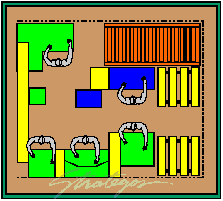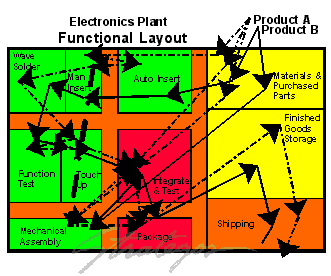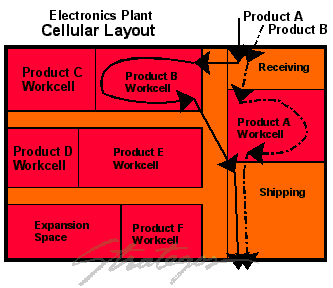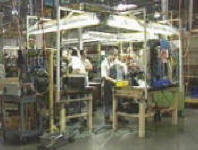Workcells
The Heart of Lean Manufacturing
Workcells In Lean Manufacturing
Cellular Manufacturing and workcells are at the heart of most Lean Manufacturing. Their benefits are many and varied. They increase productivity, quality, and delivery reliability. At th same time workcells simplify scheduling, material flow, management and even accounting systems.
Cellular Manufacturing seems simple. But beneath this deceptive simplicity are sophisticated Socio-Technical Systems. Proper functioning depends on subtle interactions of people and equipment. Each element must fit with the others in a smoothly functioning, self-regulating and self-improving operation.

What Is A Workcell?
A workcell is a work unit larger than an individual machine or workstation but smaller than the usual department. Typically, it has 3-12 people and 5-15 workstations in a compact arrangement. An ideal cell manufactures a narrow range of highly similar products. Such an ideal cell is self-contained with all necessary equipment and resources.
Cellular layouts organize departments around a product or a narrow range of similar products. Materials sit in an initial queue when they enter the department. Once processing begins, they move directly from process to process (or sit in mini-queues). The result is very fast throughput. Communication is easy since every operator is close to the others. This improves quality and coordination. Proximity and a common mission enhance teamwork.
Simplicity is an underlying theme throughout cellular design. Notice the simplicity of material flow. Scheduling, supervision and many other elements also reflect this underlying simplicity.
The Benefits of Cells
Figures below contrast functional layouts, and cellular operations. The example is from an electronics plant. In the functional configuration, departmental organization is by function (or process). Since each board requires all (or most) processes, it travels to every department. In each department, it sits in queue waiting for processing. Ten process steps require ten queues and ten waits. Travel distances are long, communication is difficult and coordination is messy. Our article on Lean Manufacturing Benefits has considerably more detail or you can download the Workcell Design chapter from Mr. Lee's latest book.
Designing Workcells
Every cell has fundamental elements of software and hardware. The designer should explicitly specify each element to ensure that it suits its purpose and fits the design. All too often, we see workcells where some elements, such as layout, are carefully designed and others come about by happenstance. The link below leads to an article with more information on workcell design. Process and Value Stream Mapping are also valuable tools. See our articles on Workcell Design for more detail.
An Example
A firm that assembles air-handling products faced high inventories and erratic delivery. They originally assembled units on a traditional line. Long setups and logistics required long production runs. Often, they pulled products from finished goods and rebuilt them for custom orders.
We built twelve small (1-3 person) assembly workcells that were always set up and ready. People worked in different cells each day and assembled to customer order. Finished Goods Inventory dropped by 96%. Lead-time was 24 hours. Productivity improved by 20%-30%. The table compares cellular and functional layouts along thirteen key dimensions. It is typical of the improvements possible with this approach. Cells negate many of the tradeoffs of conventional manufacturing approaches.


|
Key Element |
Functional |
Cellular |
|
Inter-department Moves |
Many |
Few |
|
Travel Distance |
500'-4000' |
100'-400' |
|
Route Structure |
Variable |
Fixed |
|
Queues |
12-30 |
3-5 |
|
Throughput Time |
Weeks |
Hours |
|
Response Time |
Weeks |
Hours |
|
Inventory Turns |
3-10 |
15-60 |
|
Supervision |
Difficult |
Easy |
|
Teamwork |
Inhibits |
Enhances |
|
Quality Feedback |
Days |
Minutes |
|
Skill Range |
Narrow |
Broad |
|
Scheduling |
Complex |
Simple |
|
Equipment Utilization |
85%-95% |
70%-80% |
Cellular Manufacturing Video
Workers explain how they designed, built and operated their own workcell and the positive changes it has brought.
■ ■ ■ ■ ■ ■ ■



